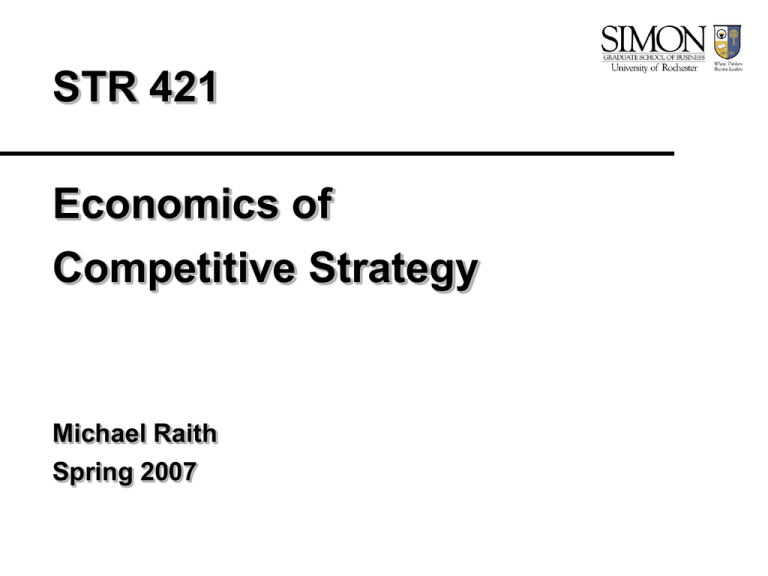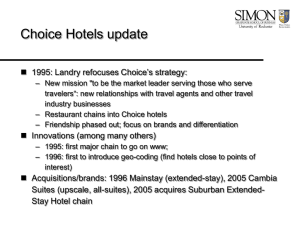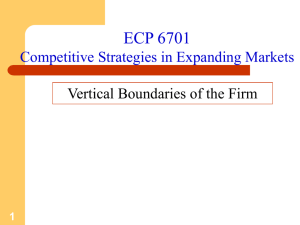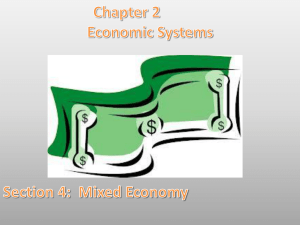Lecture - Simon Business School
advertisement

STR 421 Economics of Competitive Strategy Michael Raith Spring 2007 3. The scope of the firm Horizontal scope: to what extent should a firm expand into new products or businesses? – CCS: diversify into plastics? – Choice Hotels: pros and cons of covering full quality spectrum Vertical scope: To what extent should a firm be involved in activities further upstream or downstream in the production chain? – Coors: backward integration into everything – Reynolds, beverage producers: integration into metal cans – Dell vs. Compaq: resellers Closely related but not focus here: mergers within industry Today’s class 3. The scope of the firm 3.1 Expanding scope: problems and challenges 3.2 Expanding scope to realize synergies 3.3 Expanding scope to increase market power Bad/questionable reasons to diversify “We need to grow” – Profitability often leads to growth, but growth for its own sake is rarely profitable – Agency problem: managers want growth because their influence & compensation depends on it – Managers often prefer to spend “free cash flow” on growth strategies and pet projects than pay it out to shareholders – Similar: diversification efforts in industries with declining profitability Metal cans More questionable reasons Diversify in production to reduce financial risk? – Shareholders can instead diversify in financial markets Diversified firm as source of investment funds? – Assumes financial market failure that can be overcome internally …and one more: Spread unique skills & capabilities into new industries? – “Superior skills” exist but are hard to assess/verify – Managers of successful firms often overestimate scope and uniqueness of their capabilities – Probably one of the major reasons why many acquisitions fail Many empirical studies document a “diversification discount”, suggesting that firms often diversify for the wrong reasons Bad reasons to vertically integrate “Produce in-house to avoid paying a profit margin to independent firms” – If input market is competitive, “profit margin” is expected return on invested capital = part of economic cost – Examples: resellers in PC industry; car rental: fees for reservation systems “Outsource to avoid certain costs of production” – E.g. outsource transportation to avoid maintenance & depreciation of trucks See BDSS for other make-or-buy fallacies Organizational costs of integration/ expansion in scope Dilution of incentives of division managers Specialized resources spread too thin Management too complex, problems more difficult to detect Many additional problems when two existing firms with different organizations, cultures are merged – CCS-Continental Can Two main ways to expand scope 1. Internal development = Integration by developing own capabilities in target industry/market – This is like an entry decision – What are the barriers to entry? – Do we have a competitive advantage? 2. Acquisition of existing company – Current owners must be compensated for profits they give up – Acquisition must increase total value created between the two companies! Compare Choice Hotels: new brand introductions vs. acquisitions What if several bidders compete for acquisition target? Suppose firm A thinks of selling its unit X. A is worth $50M when it owns X; worth only $30M without X. Two bidders: – Firm B is worth $40M without X but $65M if acquires X – Firm C is worth $70M without X but $100M if acquires X Who will buy X and at what price? Winning makes sense only if acquisition leads to larger increase in total value than for any other bidder! “Winner’s curse” if value of target is overestimated Today’s class 3. The scope of the firm 3.1 Expanding scope: problems and challenges 3.2 Expanding scope to realize synergies 3.3 Expanding scope to increase market power 3.2 Integration to realize synergies Parallel discussion of horizontal and vertical scope because central questions are the same: – What are the synergies/sources of economies of scope? – Is integration better than contractual solutions? The main good reason to expand scope is to take advantage of lower costs or a higher benefit. Economies of Scope: 1. Efficient use of resources Production facilities and people – Hollywood studios: movies and TV shows – Pharmaceuticals: lab equipment – Sales forces to sell different products Related: benefits of geographical proximity; e.g. beverage bottling and can production Umbrella branding: Sony, Disney, Virgin, Choice Hotels Through transfer of organizational capabilities – Philip Morris’ marketing skills applied to Miller Brewing Co. – IBM’s Engineering and Technology Services division 2. Benefits from bundling for buyers Convenience for buyers of buying multiple products through same channels: – Disney: movies, parks, toys, cruises etc. – Masco Corp.: consumer brands for home improvement/construction market Convenience of choice: Choice Hotels Lower costs of purchasing complementary goods: Starbucks and Hear Music stores 3. Coordination and other externalities in production Knowledge spillover: – Pharmaceuticals: knowledge spillover – Reynolds in aluminum cans – Intel: microprocessors and ProShare videoconferencing? Product design and quality control – – – – Hardware and software: Apple, Nintendo vs. Atari in 80s PC Resellers: hardware and software support Coors’ own trucking subsidiary to transport beer Business school course packets Advances in IT (making coordination easier) are one reason for general trend towards outsourcing 4. Externalities in pricing of complementary products Recall oligopoly pricing: firms cutting price don’t take negative effect on competitors into account Complementary products: firms don’t take positive effect of cutting price on competitors into account Charge prices that are too high! Less business for both firms Integration may be only way to solve problem Careful, though: argument assumes some degree of market power in both markets! Examples Cars and financing: GMAC (est. 1919, divested 2006), Ford Motor Credit (est. 1959), founded when credit markets were less competitive/efficient – Also possibly: transaction costs for buyers Michelin: tires and guidebooks? – Also possibly: lower production costs The vertical counterpart: Double marginalization Same in vertical production chains; e.g. manufacturer, retailer – Both provide complementary goods/services! – Retailer’s price > wholesale price; manufacturer’s price > MC Problem: retail price higher, and total profits lower than if prices were coordinated/ if upstream & downstream firm were integrated Example: Brewers and pubs in the U.K. – In late 1980’s, many pubs were owned and managed by brewers – Antitrust authority forces brewers to divest some of their pubs – Slade (1998) finds that beer prices in pubs subsequently increased and industry profits decreased Again, argument applies only if both upstream & downstream firm have market power! But why integrate?? Many economies of scope can be realized through contracts, without integration When that is possible, it’s much easier than integration Integration best if contracts don’t work well – Why did Fedex buy Kinko’s in 2003? Why did Disney merge with ABC? Both pairs had established relationships before Think of “buy” instead of “make” as default, see if there are reasons to “make”. Independent suppliers… – often benefit from scale & scope economies, experience – have better incentives to keep costs low and improve products Examples of contracting solutions Use of resources: – Manufacturer’s representatives – Reservation systems for car rental, flights Coordination/quality – Nintendo and external game producers – Supply chain management at Dell Complementary products – Partnerships to offer discounts: Choice Hotels Pricing in vertical chains – Non-linear pricing in franchising – Gasoline: retail price maintenance as upper limit on price Contracting problems Costs of describing and measuring quality of performance Costs of describing the terms of a contract – E.g. B-school packets: costs of specifying penalties Costs of agreeing on prices for resources to share, or on contributions to their costs – Underlying problem: parties have private information about what resource is worth to them Unwanted leakage of proprietary knowledge Legal constraints: price fixing prohibited The holdup problem 1. Companies often make relationship-specific investments = useful only when dealing with a particular business partner – E.g. setting up a can factory near Coca-Cola 2. Contracts are often incomplete for any of the above reasons – E.g. increase in cost of aluminum may require adjustment of can price The firm that made a specific investment may later be “held up” by the other – E.g. Coca-Cola might say: your past investment in your plant is your problem; let’s look forward – Consequence: firm making investment may not get its expected return The firm then has less incentive to invest in the first place => inefficient outcome! Integration as solution to the holdup problem Possible solution: vertical integration (Coke produces its own cans), unless it’s possible to write long-term contracts Examples: – Automobiles (Monteverde and Teece, 1982): Components requiring high engineering effort (specific human capital) more likely to be produced in-house. – Aerospace industry (Masten, 1984): components with design specific to company more likely to be produced in-house. – Electric utilities: “Mine-mouth” electric utility plants more likely to be vertically integrated with mines than others (Joskow 1985). – Electronic components (Anderson and Schmittlein, 1984): components with greater human capital specificity ( = salespeople’s effort to learn about it) more likely to be sold through in-house sales force. Scale economies and firm/market size “The division of labor is limited by the extent of the market” 1. Make if no one else has use for the same input, or because input is unique – Independent suppliers would not want risk of holdup – Integrated cell phone makers: Nokia, Ericsson, Motorola 2. Buy if independent supplier can sell to others as well – Solves two problems: reduces holdup risk, helps realize EOS – Small cell phone makers that purchase standard components – Small companies selling through manufacturer’s representatives 3. Possibly make if the quantity you need is large enough to realize all scale economies – Big companies often prefer to have an in-house sales force – GM more integrated than Ford Today’s class 3. The scope of the firm 3.1 Expanding scope: problems and challenges 3.2 Expanding scope to realize synergies 3.3 Expanding scope to increase market power Integration and market power So far, considered reasons to integrate that are purely between two firms (and their buyers) Other possible reasons are to increase market power over other firms Often stated as reasons for M&A in practice But whether they are good reasons is much less clear Horizontal scope and bargaining power Diversify to increase bargaining power vis-à-vis buyers or suppliers? – Important reason for horizontal mergers, e.g. hospitals Choice Hotels and suppliers – Rarely main reason for diversification But e.g. Pepsi-Quaker Oats: influence in distribution channels Foreclosure Integrate into another stage of vertical chain to make competitors’ access to suppliers or customers difficult or impossible => raise rivals’ costs Examples: – U.S. Steel’s acquisition of iron ore mining rights in early 20th century – Murdoch’s acquisition of DirecTV in 2003: greater control over distribution of programming may place other producers (e.g. Time-Warner [CNN], Disney [ESPN)] at disadvantage Foreclosure (cont’d) Potential problems with this strategy: 1. need barriers to entry in target industry 2. threat of antitrust intervention 3. winners might be owners of the scarce input Not much evidence that this strategy is effective BDSS consider this argument a make-or-buy fallacy (#5)! “Leveraging” market power Can a firm “leverage” its market power into another market through integration and tying? Can NewsCorp, with market power in programming (Fox), increase its power over cable companies (=downstream firms) by buying DirecTV? Popular argument, but hard to get to fly: works only if it prevents entry / induces exit in target market











![sirower [synergy] - Columbia Business School](http://s3.studylib.net/store/data/008625403_1-88832097b24e6e902e25af41e21ba254-300x300.png)